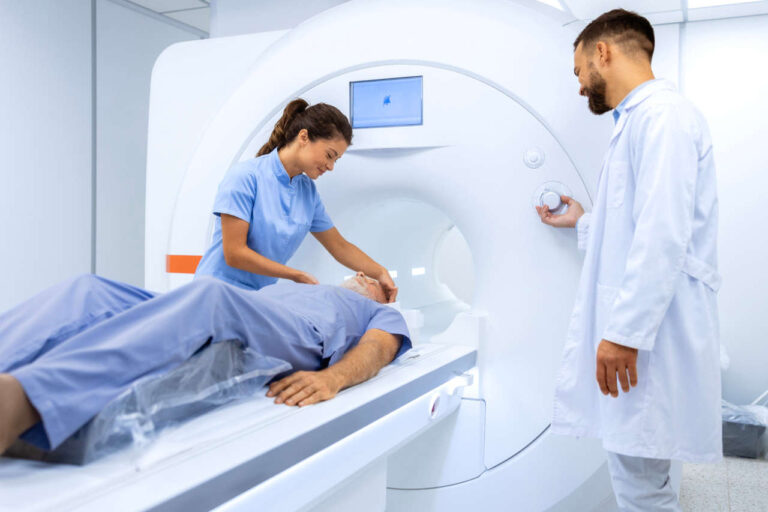
Hypogammaglobulinemia is a disorder caused by low levels of serum immunoglobulins or antibodies. Immunoglobulins (IG) are the main components of immune response and can recognize antigens (foreign substances) to trigger an immune response and eliminate the infection. There are several different types of immunoglobulins (i.e., IgA, IgM, IgG, and IgE).
Hypogammaglobulinemia refers to a specific laboratory finding of low immunoglobulin G, or IgG. When IgG levels are below the normal range, it can cause recurrent infections (like the flu, strep throat, etc.), allergies, asthma, and a weakened immune system. The most commonly recognized clinical feature is recurrent infection. IgA deficiency is a separate diagnosis, but it can eventually lead to a loss of IgG or may occur concurrently. Treatment options vary based on patient needs and disease severity. Hypogammaglobulinemia is considered a common primary immunodeficiency, and it includes the majority of immune-compromised patients.
Get IVIG Copay Assistance
IVIG Financial AssistanceWho Can Get Hypogammaglobulinemia?
Hypogammaglobulinemia can be inherited genetically or attained through time. It can be present in males or females of all ages, but it is most commonly seen in males. Hypogammaglobulinemia may present in infants and children and is usually stabilized by the age of 6.
Causes of Hypogammaglobulinemia
Hypogammaglobulinemia could be acquired or be secondary due to other underlying diseases or syndromes. Different underlying immune defects can lead to hypogammaglobulinemia, including:
Primary Immune Deficiencies:
- Common Variable Immunodeficiency (CVID)
- This is the most common cause of hypogammaglobulinemia. CVID is characterized by decreased IGs and antibodies, making patients more susceptible to infections.
- CVID is also presented with an increased incidence of inflammatory manifestations and susceptibility to cancer.
- It can be inherited or can develop during a lifetime.
- X-Linked Agammaglobulinemia (XLA)
- XLA is rare, yet it is the first primary hypogammaglobulinemia immunodeficiency with an identified genetic cause.
- XLA is an inherited disease in which a patient can’t produce antibodies.
- Autosomal Recessive Agammaglobulinemia (ARA)
- ARA is an inherited disease in which a patient can’t produce antibodies, very similar to XLA.
- Specific Antibody Deficiency (SAD)
- In this syndrome, the total levels of all isotopes of IGs are in the normal range, but the body does not make sufficient quantities of specific antibodies.
- Transient Hypogammaglobulinemia of Infancy (THI)
- THI is another common disorder, affecting infants over six months of age without showing any symptoms.
- THI is characterized by low levels of IgG with or without decreased IgM and IgA.
- Infants are affected due to suppressive maternal antibodies that come through the placenta and suppress fetal IG production, irregular cytokine production, or abnormal T or B cells.
- Hyper-IgM (HIGM) Syndrome
- This is a rare cause characterized by decreased levels of IgG, IgA, and IgE in the blood and increased IgM levels, which are caused by the alteration in genes on certain chromosomes.
- The most common form of HIGM is inherited as x-linked.
- Without proper treatment, this disorder can be fatal.
- Selective Immunoglobulin A Deficiency (SIgAD)
- SIgAD is characterized by decreased IgA levels in the blood and secretions but no other immunoglobulin deficiencies. It also involves B cell abnormalities.
- Though the inheritance pattern is unknown, having a family member with this condition of any age group doubles the risk.
- Patients with CVID, treated with drugs like phenytoin or D-penicillamine, were diagnosed with secondary IgA deficiency. Different infections like Rubella, CMV, and EBV may also be the underlying cause.
- IgG Deficiency of Subclasses
- In this syndrome, the total IgG level is normal; however, one or more subclasses are below the normal range. In certain cases, other Igs are also low.
- Immunodeficiency With Thymoma
- This is a rare disorder, also known as the good syndrome.
- It involves combined B and T cell immunodeficiency in adults.
- Other Isolated Non-Immunoglobulin G Deficiencies
- In these syndromes, there would be a deficiency of IgA in patients with normal IgM and IgG levels. This is most common in children above age 4.
Can IVIG help?
Free IVIG Treatment Info | Difficulty In Diagnosing?Secondary Immune Deficiencies:
- More often, hypogammaglobulinemia develops as a result of another condition, called secondary immune deficiencies. These include:
- Nephrotic syndrome
- Protein-losing enteropathy
- HIV
- Poor nutrition
- Organ transplant
- Radiation
- Blood cancers like:
- Chronic lymphocytic leukemia (CLL)
- Acute lymphoblastic leukemia (ALL)
- Multiple myeloma (could be drug-induced)
- Certain medications can lead to hypogammaglobulinemia, such as:
- Corticosteroids
- Chemotherapy agents
- Antiseizure agents
- Drugs that suppress the immune system
Signs and Symptoms
There are situations where hypogammaglobulinemia presents no symptoms and may present symptoms years after its onset. In cases of mild hypogammaglobulinemia, patients will remain asymptomatic. However, in severe cases, the clinical manifestation of symptomatic hypogammaglobulinemia is a predisposition towards recurrent infections, which the body defends by antibody response. Other symptoms can include ear or skin infections, gastrointestinal problems, allergies, asthma, and diarrhea.
Common infections include:
- Bronchitis
- Ear infections
- Strep throat
- Skin infections
- Pneumonia
- Meningitis
- Eczema
- Sinus infections
Diagnosis
Various laboratory tests are conducted to establish a successful diagnosis and determine which phenotype is deficient. The main lab test done is called the complete blood count (CBC). Chest X-ray or CT scans may be useful for patients with THI. Tests are also done for vaccine antigen responses with certain conditions. Additional diagnostic tests include kidney studies for urinary excretion of proteins for 24 hours and histological findings, such as intestinal biopsy, lymph node, and thymus biopsy.
Treatment Info
Get IVIG Prior AuthorizationTreatment
Early diagnosis of hypogammaglobulinemia and several treatment therapies (antibiotics and immunoglobulin replacement therapy) may help to enhance life expectancy and allow patients to live a relatively normal and active life. Although there is no curative therapy for hypogammaglobulinemia genetic disorder, there are several different types of treatment options, depending on the patient’s condition and type of immunodeficiency. The main goals for treatment are to prevent organ damage, decrease disease severity, reduce morbidity, treat any infections, and improve health-related quality of life. Management is customized for individuals according to the underlying cause. Some patients remain asymptomatic throughout life and need no intervention.
Bacterial infections are treated with antibiotics. Those who get severe or frequent bacterial infections may need to take antibiotics for several months at a time to prevent them from recurring. Antibiotics are also prescribed for prophylaxis to prevent life-threatening infections. In order to minimize the risk for infection, it is important to avoid crowds, unhygienic street foods, certain vaccines, etc. It is important to notify your physician prior to taking any vaccines, especially live vaccines. Live vaccines may make people who are immunocompromised ill because of underlying problems with their immune response.
Immunoglobulin replacement therapy (IRT) is a standard, lifelong, and life-saving treatment for hypogammaglobulinemia genetic disorder. Immunoglobulin replacement therapy not only boosts the patient’s immune system but also improves the patient’s survival rate and quality of life by providing the missing immunoglobulins in the body. If severe hypogammaglobulinemia is suspected, IRT may be recommended. This will help replace and replenish what the body is not making. IRT can be given to hypogammaglobulinemia patients either intravenously (through the veins, known as IVIG) or subcutaneously (under the skin, known as SCIG). Injected immune globulin comes from the blood plasma of healthy donors. Some may only need a single injection of IRT. Others may need to stay on this treatment for a year or more. Blood tests may be warranted every few months to check levels until they are normalized.
In other rare instances, especially if T-cell function is altered, hematopoietic stem cell or bone marrow transplants may be warranted. If secondary immunodeficiency is present such as HIV or nephrotic syndrome, treatment of that disease or condition can help improve Ig levels.
Consult an IVIG Specialist
The Best IVIG Home Infusion | Get IVIG Treatment AssistanceComplications
Complications depend on what caused hypogammaglobulinemia, and what types of infections are involved. They can include:
- Autoimmune disorders such as Crohn’s disease and ulcerative colitis
- Damage to the heart, lungs, nervous system, or digestive tract
- Increased risk for cancer
- Repeated infections
- Slowed growth in children
Getting treated for infections and taking immunoglobulin therapy can reduce the risk of these complications.
Prognosis
The life expectancy and prognosis of hypogammaglobulinemia may rely upon the individual’s immunodeficiency, its type, and severity. Those who get many severe infections will have a worse outlook than those who don’t get as many infections. Research shows that Immunoglobulin replacement therapy (IRT) combined with antibiotic therapy for infections dramatically improves the outlook for patients with CVID. However, morbidity and mortality due to recurrent and life-threatening infections remain a significant concern. In addition, susceptibility to lymphomas is another possibility in the long term.
Most individuals with XLA who get immunoglobulin regularly will be able to live everyday lives. The prognosis of THI for symptomatic patients is good, and the IgG levels become normal by 3 to 4 years of age. While SCID remains a medical emergency, with successful stem cells, the transplantation survival rate is increased up to 93%. Some patients remain asymptomatic throughout most of their lifetime.
Some patients with decreased immunoglobulin A levels may develop CVID over time, while young patients can outgrow this condition within the first few years of life. HIGM patients with antibody class switching defects can be treated effectively by IRT. However, patients with T-cell defects are susceptible to more dangerous infections and may develop other autoimmune deficiencies or cancer as a result.
Catching this condition early and getting on antibiotics or immunoglobulin treatment can limit infections, prevent complications, and improve life expectancy.
Treatment Info
Get IVIG Prior AuthorizationFollow-Up
Patients with hypogammaglobulinemia or a family history of hypogammaglobulinemia should regularly get a follow-up with their physician. The following should be monitored in order to evaluate the immune response:
- Kidney function tests
- Liver function tests (LFTs)
- Growth and development
- Immunoglobulin levels
- Chest radiograph
- High-resolution computed tomography (HRCT)
It is recommended that patients get these tests done periodically for every age group, keep signs and symptoms in check, and have their physician devise respective treatment criteria (IVIG and antibiotics) as needed.
REFERENCES:
- Chaudhry A, Aniol H, Shegos C. https://www.consultant360.com/article/consultant360/congenital-hypothyroidism-due-thyroid-agenesis. Consultant. 2020. doi:10.25270/con.2020.05.00011
- Hypogammaglobulinemia: Symptoms, Life Expectancy, and Prognosis. Healthline. https://www.healthline.com/health/hypogammaglobulinemia#complications. Published 2022. Accessed March 15, 2022.
- Hypogammaglobulinemia: Practice Essentials, Background, Pathophysiology. Emedicine.medscape.com. https://emedicine.medscape.com/article/136471-overview. Published 2022. Accessed March 15, 2022.
- Immune Globulin. In: Lexi-drugs online [database on the Internet]. Hudson (OH): Lexicomp, Inc.; 2016 [updated 4 Mar 2022; cited 16 Mar 2022]. Available from: http://online.lexi.com.
- Immune Globulin. In: In Depth Answers [database on the Internet]. Greenwood Village (CO): IBM Corporation; 2017 [cited 2022 Feb 2]. Available from: www.micromedexsolutions.com.
- Immune Globulin (Intramuscular Route, Intravenous Route, Subcutaneous Route). https://www.mayoclinic.org/drugs-supplements/immune-globulin-intramuscular-route-intravenous-route-subcutaneous-route/description/drg-20444201. Published February 1, 2022. Accessed March 12, 2022.
- Pimenta FMCA, Palma SMU, Constantino-Silva RN, Grumach AS. Hypogammaglobulinemia: a diagnosis that must not be overlooked. Braz J Med Biol Res. 2019;52(10):e8926. Published 2019 Oct 10. doi:10.1590/1414-431X20198926













